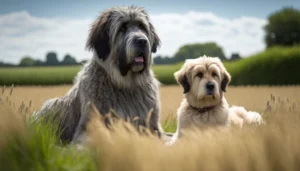Large Dog Breeds and Considerations

Dogs have been known as man’s best friend for thousands of years. These loyal and lovable creatures come in a wide variety of shapes and sizes, from the tiny Chihuahua to the giant Great Dane. For those who are looking for a larger pet, there are several dog breeds that can meet your needs. In this essay, we will explore some of the largest dogs you can get and the considerations for owning them.
Great Dane
One of the largest dog breeds is the Great Dane. These gentle giants can weigh up to 90 kilograms / 200 pounds and stand over 3 feet tall at the shoulder. Great Danes are known for their easy-going personalities and love to be around people. They are also known for being protective of their owners and make excellent watchdogs. However, their size can be intimidating to some, so it’s important to socialize them properly from a young age.
Saint Bernard
Another large dog breed is the Saint Bernard. These dogs were originally bred for rescue work in the Swiss Alps and can weigh up to 80 kilograms / 180 pounds. They are known for their calm and patient temperament, which makes them great with children. However, they do require regular exercise and grooming to keep their thick coats in good condition.
Newfoundland
The Newfoundland is another giant breed of dog. They can weigh up to 70 kilograms / 150 pounds and are known for their sweet and gentle nature. These dogs were originally bred as working dogs, helping fishermen in the icy waters of Newfoundland. They are excellent swimmers and love to be around water. However, their thick coat requires regular grooming and they can drool quite a bit.
Irish Wolfhound
The Irish Wolfhound is another breed of dog that can reach impressive sizes. They can stand up to 3 feet tall at the shoulder and weigh up to 80 kilograms / 180 pounds. They were originally bred for hunting wolves and other large game, but today they are known for their affectionate and loyal nature. However, they do require regular exercise and their large size means they need plenty of space to move around.
Tibetan Mastiff
The Tibetan Mastiff is another large breed of dog that can weigh up to 70 kilograms / 160 pounds. They were originally bred in Tibet to protect livestock from predators, and today they make excellent guard dogs. They are known for their loyalty and devotion to their owners, but their protective nature means they need to be socialized properly from a young age.
When considering owning one of these large dog breeds, there are several important factors to take into account. Firstly, their size means they need plenty of space to move around, so if you live in a small apartment, they may not be the best choice for you. It’s important to consider the size of your living space before deciding to get one of these breeds.
Temperament
Another important factor to consider is their temperament. While these dogs can be gentle and loving, their size means they can be intimidating to some people. It’s important to socialize them properly from a young age to ensure they are comfortable around people and other animals. If you have children, it’s essential to choose a breed that has a gentle and patient temperament and is known to be good with kids.
Grooming
Grooming is another important consideration. These breeds often have thick coats that require regular brushing and grooming to keep them in good condition. They may also drool quite a bit, which can be messy and require regular cleaning. It’s essential to factor in the grooming needs of the breed before deciding to get one of these dogs.
Do your research carefully
Finally, owning a large dog can be expensive. They require plenty of food, which can be costly, and veterinary bills can also be higher due to their size. It’s important to budget for these expenses before committing to owning one of these breeds.
In addition to these considerations, it’s also important to be aware of any potential health issues that these breeds may be prone to. For example, Great Danes are known to be susceptible to certain joint and bone conditions, such as hip dysplasia, which can be painful and expensive to treat. Saint Bernards are also prone to joint issues, as well as heart conditions and bloat. Newfoundland dogs are prone to obesity and certain heart conditions, while Irish Wolfhounds may be at risk for certain cancers.
It’s important to do your research on the breed you are interested in and be aware of any potential health issues they may be prone to. Regular veterinary check-ups and preventative care can help to catch any potential issues early on and ensure your dog remains healthy.
When it comes to training and exercise, these breeds require regular physical activity and mental stimulation. While they may be content lounging around the house, it’s important to provide them with regular opportunities to exercise and play. A daily dog walk or trip to the dog park can help to keep them happy and healthy.
Training is also essential for these breeds, as their size means they can be difficult to handle if they are not properly trained. Early socialization and obedience training are important to ensure they are well-behaved and comfortable around people and other animals. It’s also important to establish yourself as the pack leader early on to prevent any potential behaviour issues from arising.
Conclusion
In conclusion, owning a large dog can be a rewarding experience, but it’s important to take into account the many considerations that come with owning a larger breed. From their size and temperament to their grooming needs and potential health issues, there are several important factors to consider before committing to owning one of these breeds. With proper training, exercise, and care, these breeds can make wonderful companions for those who are up to the task of owning a larger pet.
Contact Form
contact@fourpawsonthego.com
Call Me
07533 919835


